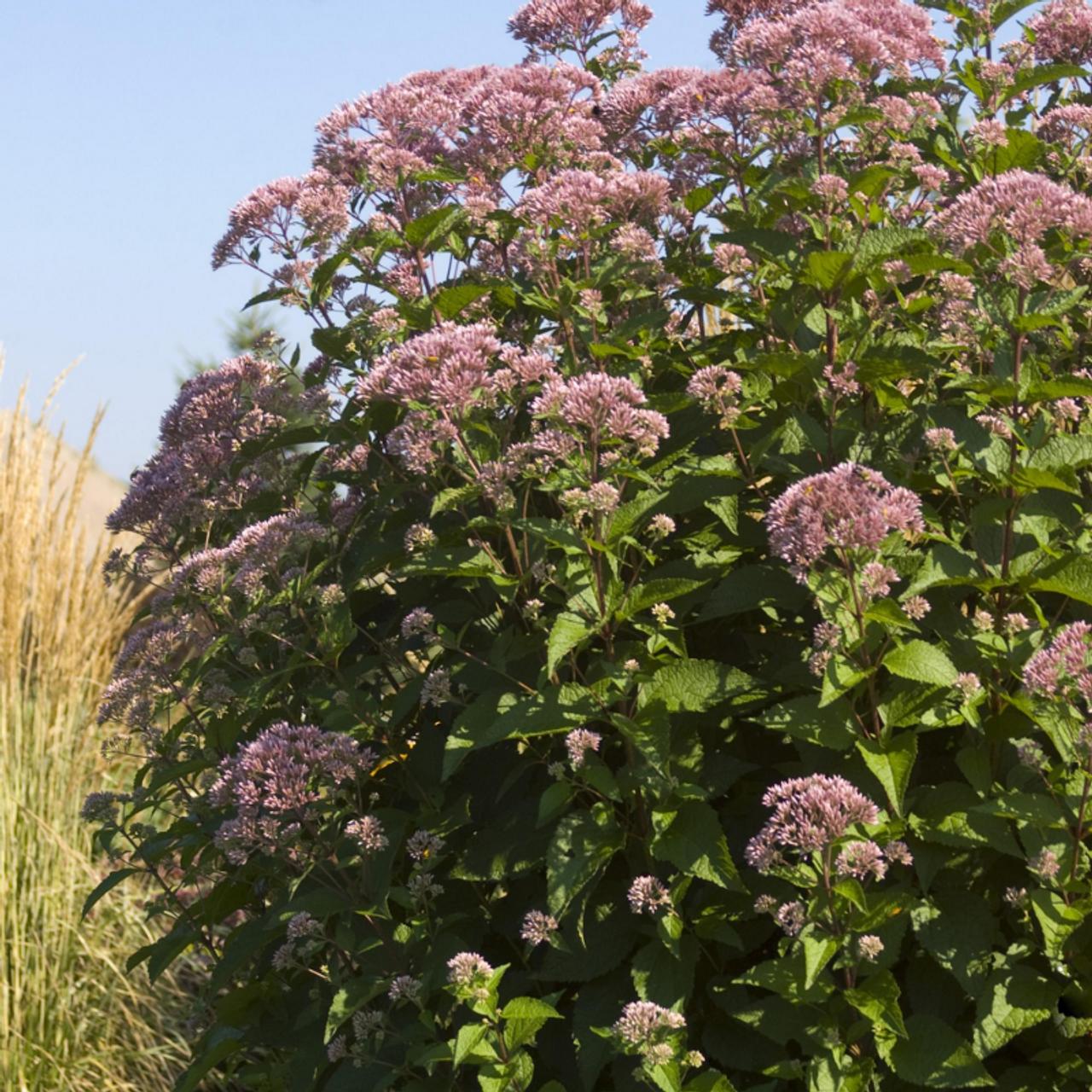
Joe Pye Weed
Uses:
- Cottage Garden
- Borders
- Container Gardens
Features:
- Attracts Pollinators
- Cut Flowers
- Low Maintenance
Sunlight:
- Full Sun With Shade
- At Least 5 Hours of Direct Sunlight
Growing Zones:
- 3-9
- What is My Zone?
Joe Pye Weed is a native perennial known for its tall stature and large, domed clusters of pink to purple flowers that bloom in late summer to early fall, attracting butterflies and other pollinators. It is perfect for planting in wildflower gardens, along pond edges, or at the back of borders, where its height can provide a striking backdrop.
About Joe Pye Weed

Gravel Root, Queen of the Meadow
North America
Perennials
Herbaceous
4-8
Pink and purple
Summer, Fall
Upright, Compact
Butterflies
Deer, winter
Deer, rabbit
How To Use Joe Pye Weed In The Garden
Joe Pye Weed, a native North American perennial, is known for its towering presence, reaching heights of 3 to 7 feet, and its clusters of delicate florets in shades of pink, mauve, lavender, orchid, or ivory. These vanilla-scented blooms are a magnet for pollinators, attracting bees, butterflies, and birds from summer through fall. This plant's adaptability to various soil types and tolerance to deer make it a favored choice among gardeners seeking both beauty and resilience.
Joe Pye Weed prefers moist environments and is ideal for planting near water features such as ponds or streams. Additionally, its substantial height and bushy growth habit provide effective natural privacy screens or backdrops in mixed borders. When paired with other perennials like bee balm, coneflowers, or Russian sage, it contributes to a dynamic and ecologically beneficial garden setting.
Types of Joe Pye Weed
| Type | Scientific Name | Native Range | Flower | Uses | Features |
|---|---|---|---|---|---|
| Spotted Joe-Pye Weed | Eutrochium maculatum | Wet meadows & fens of Eastern N. America | Flat-topped clusters of 8-20 purplish-pink disks, lightly fragrant | Rain & pollinator gardens, moist borders, naturalizing | Purple-spotted stems; deer resistant; butterfly & bee magnet; thrives in wet clay |
| Sweet/Purple Joe-Pye Weed | Eutrochium purpureum | Open woods & stream-edges of E-Central N. America | Vanilla-scented mauve-pink domed heads, 5-7 florets each | Woodland edges, cottage borders, rain gardens | Pleasant fragrance; tolerant of light shade & clay; rich nectar for butterflies |
| Coastal Plain Joe-Pye Weed | Eutrochium dubium | Atlantic coastal plain, Nova Scotia → GA | Domed 4-7 in., pale pink-to-deep purple clusters, sweetly scented | Smaller rain gardens, meadows, coastal plantings | Shortest species; mildew-resistant; accepts sandy or gravelly moist soils |
| Hollow-Stem Joe-Pye Weed | Eutrochium fistulosum | Moist lowlands of Eastern N. America | Large (12-18 in.) mauve-rose domes atop hollow purple-dashed stems | Back-of-border accents, wet meadows, wildlife plantings | Hollow stems; showy winter seed heads; outstanding butterfly appeal; tolerates periodic flooding |
Joe Pye Weed Care
Joe Pye Weed thrives in locations receiving at least six hours of direct sun daily. While adaptable to various soil types, it prefers rich, loamy soils that remain consistently moist. Amending native soil with compost can enhance growth. Water regularly during the first growing season, aiming for approximately 1.5 inches of water per week. Although not a heavy feeder, incorporating compost at planting or applying a balanced slow-release fertilizer can promote healthy development.
Joe Pye Weed thrives in locations receiving at least six hours of direct sun daily. While adaptable to various soil types, it prefers rich, loamy soils that remain consistently moist. Amending native soil with compost can enhance growth. Water regularly during the first growing season, aiming for approximately 1.5 inches of water per week. Although not a heavy feeder, incorporating compost at planting or applying a balanced slow-release fertilizer can promote healthy development.
Learn More About Joe Pye Weed Care

Joe Pye Weed Companion Plants
Joe Pye weed reaches its full potential in moist, steadily watered soil that never puddles and a location with unfiltered sun. Crape myrtle echoes the wildflower’s prairie scale yet flowers earlier in high summer, then its peeling bark and airy canopy frame Joe Pye weed’s late plumes. Oakleaf hydrangea’s broad leaves and autumn color give the border depth, shade for roots, and a seamless seasonal hand‑off. At ground and mid‑level, balloon flower supplies a spring‑through‑early‑summer burst of purple‑pink bells that harmonize with Joe Pye weed’s later mauves. Moisture‑tolerant ornamental grasses weave between the clumps, adding movement, erosion control, and a fine‑textured counterpoint to the stout stems.










